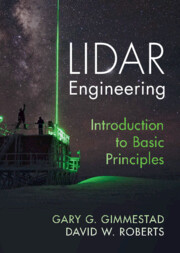Book contents
- Lidar Engineering
- Lidar Engineering
- Copyright page
- Dedication
- Contents
- Preface
- Glossary
- List of Abbreviations
- 1 Introduction
- 2 The Basic Lidar Models
- 3 The Molecular Atmosphere
- 4 Particles in the Atmosphere
- 5 Lidar Transmitters
- 6 Lidar Receivers and the Geometrical Function
- 7 Optomechanics
- 8 Optical Detection
- 9 Data Systems
- 10 Lidar Data Analysis
- 11 Applications
- Appendix A The Klett Retrieval
- Index
- References
2 - The Basic Lidar Models
Published online by Cambridge University Press: 16 February 2023
- Lidar Engineering
- Lidar Engineering
- Copyright page
- Dedication
- Contents
- Preface
- Glossary
- List of Abbreviations
- 1 Introduction
- 2 The Basic Lidar Models
- 3 The Molecular Atmosphere
- 4 Particles in the Atmosphere
- 5 Lidar Transmitters
- 6 Lidar Receivers and the Geometrical Function
- 7 Optomechanics
- 8 Optical Detection
- 9 Data Systems
- 10 Lidar Data Analysis
- 11 Applications
- Appendix A The Klett Retrieval
- Index
- References
Summary
The photon signal-to-noise ratio (SNR) is defined in terms of statistical quantities, and the Poisson and Gaussian probability distribution functions are defined and described. Those distributions are applied to lidar measurements, and the effect of background light on lidar SNR is quantified. The signal-limited and background-limited SNR regimes are defined. The lidar equation is then introduced as a model of the range-dependent lidar signal, and the background model is a constant additional term. All the variables in both models are introduced and defined. They include the number of photons in each laser pulse, the optical efficiencies of the transmitter and receiver, the geometrical function, the receiver solid angle, the range bin length, the volume backscatter coefficient, the extinction coefficient, the spectral radiance of the background, the receiver field of view, the receiver optical bandpass, and the sampling interval of the data system. Finally, a lidar system known as the Eye safe Atmospheric Research Lidar (EARL) is introduced because it is used as an example throughout the rest of the book.
Keywords
- Type
- Chapter
- Information
- Lidar EngineeringIntroduction to Basic Principles, pp. 13 - 29Publisher: Cambridge University PressPrint publication year: 2023

